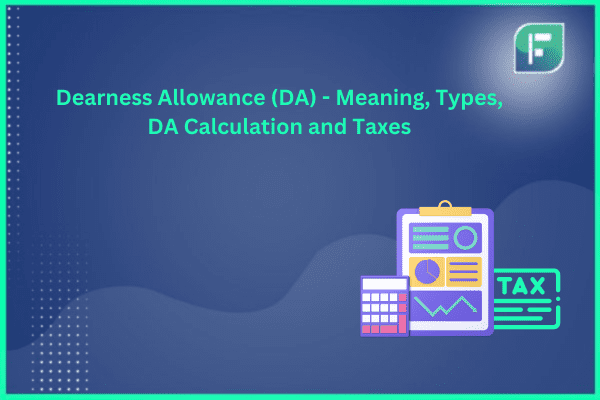In a world wherein inflation is inevitable, dearness allowance has grown to be a major element of employee pay – especially in the public sector. This allowance helps employees cope with rising prices while not losing purchasing power. This blog will discuss dearness allowance – meaning, types, calculations and tax consequences.
Dearness Allowance Meaning
Dearness allowance, sometimes called DA, is a cost-of-living adjustment paid to workers to compensate inflation – affecting buying power. It’s a variable element of a worker’s wage which is regularly modified to reflect changes in the Consumer Price Index (CPI) way of measuring inflation. The principal purpose of DA is to guarantee that employees can live comfortably by paying for lost real income due to rising prices.
Types of Dearness Allowance
There are two sorts of dearness allowance:
- Industrial Dearness Allowance (IDA): This particular kind of DA is provided to public sector workers of the Central Government. The IDA is adjusted quarterly according to the CPI for inflation.
- Variable Dearness Allowance (VDA): The VDA is open to Central Government workers and it is reviewed every 6 months consistent with the CPI. It consists of 3 parts: A fixed base Index, a fluctuating Consumer Price index and also the variable DA amount fixed by the government.
DA Calculation dearness allowance is calculated differently for Central Government workers and public sector workers. Formulas used are:
For Central Government Employees:
DA% = ((Average of AICPI (Base Year 2001 = 100) for the last twelve months – 115.76)/115.76 x 100
For Public Sector Employees:
DA% = ((Average of AICPI (Base Year 2001 = 100) for the last three months – 126.33)/126.33 x 100
Here AICPI stands for All India Consumer Price Index or measure of inflation.
DA Calculation Sheet and DA Calculator Tools & Resources
To help calculate dearness allowance, a DA calculation sheet is a spreadsheet program that performs the calculation using the previously mentioned formulas. Employees or employers can enter the data like basic salary and AICPI values and the sheet will calculate DA amount.
There are also online dearness allowance calculators that work similarly to the calculation sheets but with an easier interface. These calculators show step wise guidance and can include extra features like tax calculations or comparisons among similar situations.
How To Calculate Dearness Allowance in India?
To Calculate Dearness allowance manually, follow these steps:
- Get the latest AICPI values for the relevant period (twelve months for Central Government employees/3 months for public sector employees).
- Find the mean of the AICPI values for the specified period.
- Within the respective formulas, enter the average AICPI value and the base index (115.76 for Central Government employees and 126.33 for public sector workers).
- Do the computation to get the DA%.
- Divide the DA proportion by the basic salary to obtain the dearness allowance amount.
DA Rates 2024
Dearness Allowance is commonly noticed In India, particularly In the public sector. The Central Government along with some state governments periodically revise the DA rates of their workers as per the Pay Commissions recommendations.
The Central Government raised the DA by 4% for its workers recently, making the DA rate half of the base wage as of Jan 1, 2024. This increases the take home salary of central government workers to cope with growing living expenses.
Dearness Allowance is primarily a public sector item, however some private businesses grant a similar allowance to their workers. Private companies are usually more flexible in determining the components of their employee compensation packages such as dearness allowance inclusion and calculation.
Tax Implications of Dearness Allowance
Dearness allowance is taxed in India for salaried personnel. It’s taxable together with the employee’s income and the DA component is reported separately on the income taxes. DA extended to salaried workers is taxable at 100%. However, when the employee is provided with unfurnished rent free accommodation, part of the DA might be taxable under certain conditions and retirement benefit salary limits.
Closing Thoughts
Dearness allowance maintains the purchasing power of personnel – particularly in the public sector where it’s a required part of compensation. Both employees and employers need to know the meaning, types, calculation techniques and tax consequences of DA. Working with tools like DA calculators & calculation sheets, DA can be computed more quickly and easily to adjust employee salary.
FAQs
What is DA and how is it calculated?
DA is a wage supplement given by the employer to the worker. It’s a cost of living adjustment driven by inflation for personnel convenience. It’s a taxable allowance attached to the gross salary.
What are the types of dearness allowance?
Types of DA – CPI based and Industrial Average-based. The base index, CPI, Industrial Average, inflation, cost of living, employer policies and frequency of revision impact the calculation of DA.
Is DA paid monthly?
The DA is revised every six months. The modification in it stems from a change in the consumer price index (CPI) which leads to a revised DA for employees.
On what basis is DA calculated?
As DA is dependent upon cost of living, this salary part is variable. It varies between a public sector employee and another depending on where the employee will work. Consequently DA allowance differs for employees in rural, urban and semi-urban sector. DA rates change two times yearly.
What does DA mean in income tax?
DA extended to salaried workers is taxable at 100%. When the employee is provided with unfurnished accommodation free of charge, DA is the component of retirement benefit salary (in case the conditions are met).
What is the primary distinction between HRA and DA?
DA is to be distinguished from HRA as they are two distinct components and treated differently for income tax purposes. A significant difference is that HRA (House Rent Allowance) is accessible to private and public sector workers whereas only public sector workers are eligible for DA.






